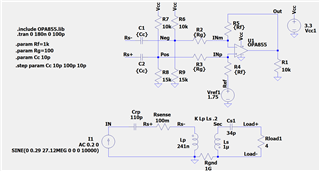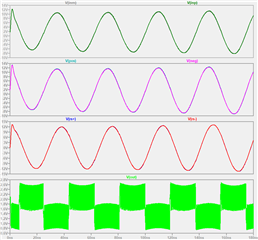Hi everyone,
I am looking for some assistance on an amplifier circuit used to sense a current at 27 MHz. Some of the spec's I am looking for in the circuit:
Power supply: 3.3 Vdc, single sided,
-30 mV < Vdiff < +30 mV
-1 V < Vcm < +22 V
Desired Gain: > 20 V/V
Because of the high frequency and potentially high common-mode voltage, I could not simple current sensing amp (one of the INAxxx devices, for example). I choose to make a difference amp using the OPA855 and am looking to get the maximum voltage swing out of it (if I need more gain I can add another stage). However, I cannot get the amplifier to work, at least in LTSpice, with my circuit, shown below:


I thought I could DC bias the inputs to the middle of the acceptable Vcm range (~2.0 VDC) and couple the high-frequency differential in. I then add a Vref to set the output common-mode voltage to the middle of the output swing range (1.15-2.35 V, so set Vref to 1.75 VDC in the above circuit). However, I am not getting the expected output. First, even with just a 10 pF of coupling capacitance, the Vcm at the input pins seem to stray way out of range and the output looks horrible. I am trying figure what's going on but am at a loss. Can anyone comment if I am missing something? Any thoughts would be appreciated!
Thanks
John

